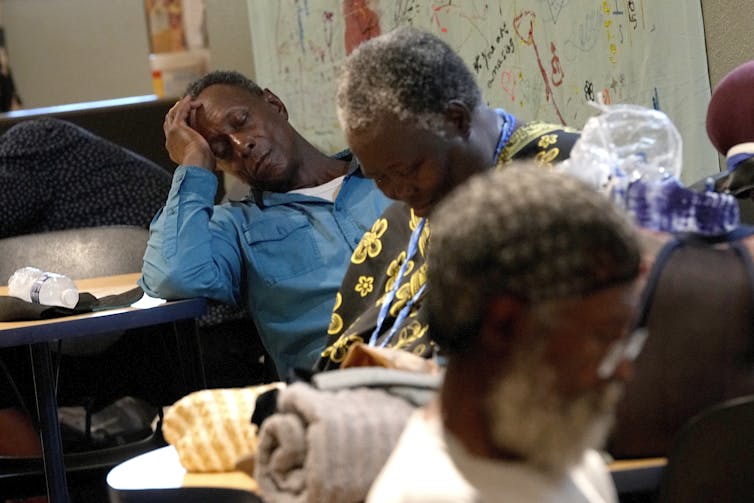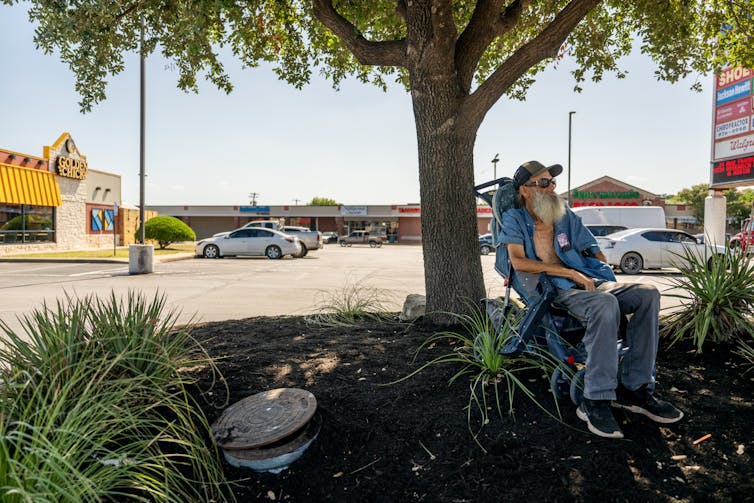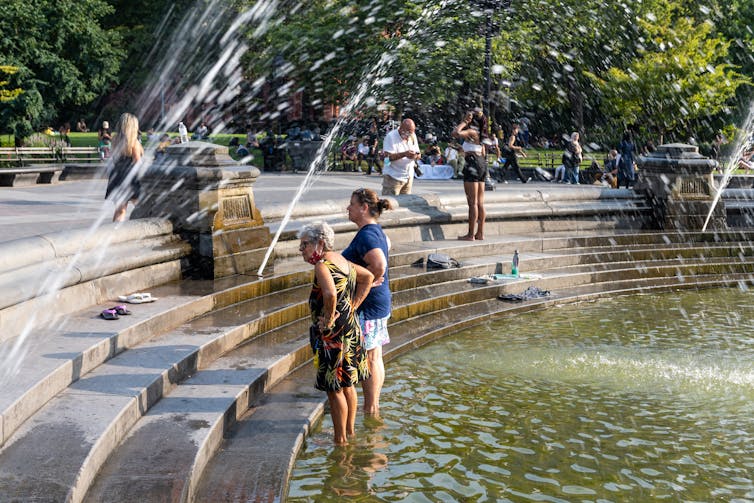Extreme heat is particularly hard on older adults – an aging population and climate change put ever more people at risk
Scorching temperatures have put millions of Americans in danger this summer, with heat extremes stretching from coast to coast in the Southern U.S.
Phoenix hit 110 degrees Fahrenheit (43.3 Celsius) or higher every day for over three weeks in July. Other major cities, from Las Vegas to Miami, experienced relentless high temperatures, which residents described as “hell on earth.”
While the evening news runs footage of miserable sunbathers on Miami Beach and joggers in Austin, Texas, dousing themselves with water, these images conceal a growing hidden crisis: the millions of older adults who are suffering behind closed doors.
As researchers who study older adults’ health and climate change, we have found that two societal trends point to a potentially dire future: The population is getting older, and temperatures are rising.

AP Photo/Matt York
Some of the country’s hottest states, including Arizona, are forecast to see dramatic growth in their older adult populations. But heat isn’t just a problem in the South: Northern populations also face rising risks from extreme heat that many people aren’t accustomed to.
Communities, families and older residents need to understand these risks and be prepared.
Why older adults face higher heat risks
Triple-digit temperatures are miserable for everyone, but for older adults they can be deadly.
Older adults don’t sweat or cool down as efficiently as younger people. Heat stress can worsen underlying conditions like heart, lung and kidney disease, and extreme heat can trigger delirium.
Poor air quality makes it harder to breathe, especially among people who already have breathing difficulties. For older adults with physical health problems, temperatures as low as 80 degrees F (26.7 C) – to say nothing of 110 degrees – can pose a grave danger.
Prescription medications make older people more sensitive to heat. Anticholinergics, used to treat chronic obstructive pulmonary disorder, or COPD, reduce our capacity to sweat. Dehydration is a side effect of beta blockers and diuretics, which are used to help control blood pressure.
Medications also work best when stored at room temperatures of 68 to 77 degrees and may lose their effectiveness if not kept in a cool place on a very hot day.

Brandon Bell/Getty Images
And it’s not just physical health that suffers.
Having to stay indoors all day to keep cool and enduring the stress of heat emergencies can make older adults depressed and isolated. Those with cognitive problems or dementia may not understand their health risks or may not take proper precautions. Seniors with physical disabilities, limited mobility or lack of access to transportation can’t easily travel to a public cooling center – if there is one nearby.
Drawn to high-risk regions
Retirees are often drawn to the South’s sunny skies, low taxes and costs of living and amenities, like golf courses, beaches, health care facilities and age 55+ residential communities tailored to their needs. In Phoenix, the share of residents over age 65 is projected to rise from 10% of its 1.6 million residents today to roughly 17% by 2050.
At the same time that these populations are rising, the number of days people will need air conditioning is rising, too.
We used scenarios of future county-level population and climate model output from NASA to assess the consequences of moderate and dramatic warming. Our projections show that ever-rising numbers of older people are at risk of the harmful physical and mental health consequences of heat extremes.
We found that populations in historically hot locations like Arizona and desert regions of California are aging at a rapid clip, placing demands on cities, counties and states to meet the pressing needs of older residents during heat waves.
These include providing cooling centers and ensuring that they are physically accessible to those with mobility challenges, and training first responders to be sensitive to the special needs of older adults who may be reluctant to leave their homes during a heat emergency.
Communities also need to find effective ways to warn “snowbirds,” vacationers or recent migrants who might hail from cooler climates and be less aware of, or adapted to, the risks of extreme heat.
Northern regions are at risk, too
Our research finds that historically cooler places like New England, the upper Midwest and the Pacific Northwest also have rising heat risks.
These regions – historically home to high shares of older adults – are projected to experience the steepest increases in heat exposure relative to temperatures historically experienced. Older adults who are accustomed to the New England chill may not fully understand the threats an extreme heat wave can pose, and they may underestimate the harm they might suffer from a day in the hot sun.

Alexi Rosenfeld/Getty Images
Older homes in the Northeast also tend to have less efficient cooling systems. Nighttime heat can be particularly harmful for those without air conditioning, including people who live in densely populated Northeastern and Rust Belt cities where “heat islands” trap temperatures. For older adults with health conditions, a night of restless sleep may make one more depressed and confused during waking hours.
What you can do about it
Older adults and their caregivers can take some steps to adapt.
Stay indoors. Use air conditioning. Drink plenty of water. Don’t use the oven, especially in small homes. Help an older adult with transportation to a cooling center. Place medications in the coolest spot in one’s home. Be sensitive to symptoms like dizziness and call for medical attention as needed.
However, community-scale adaptations also are needed. Public investments in early warning systems for extreme weather, ride services to transport older adults to cooling centers and hospitals, geographic information systems to help first responders identify neighborhoods with high concentrations of older adults, and installation of energy-efficient air conditioning in homes and public settings can help to fight back against sweltering days in the future.
For all the latest Health News Click Here
For the latest news and updates, follow us on Google News.
